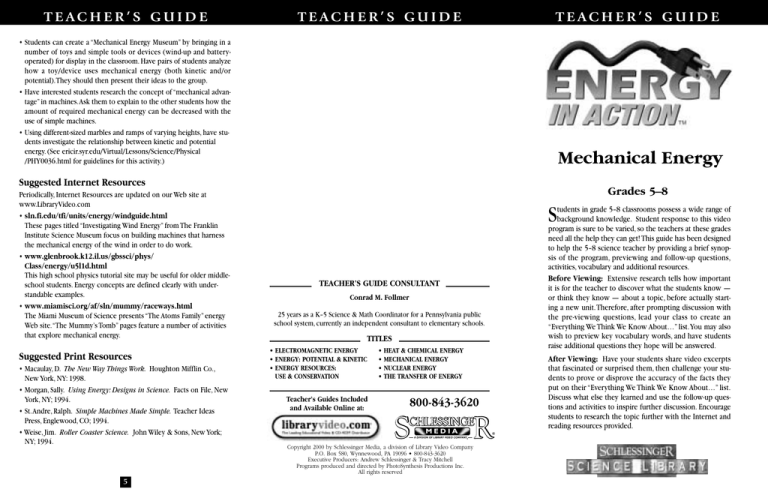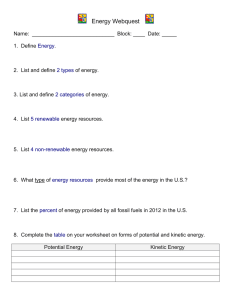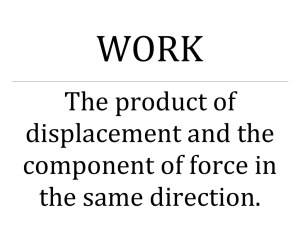
TEACHER’S GUIDE
TEACHER’S GUIDE
TEACHER’S GUIDE
• Students can create a “Mechanical Energy Museum” by bringing in a
number of toys and simple tools or devices (wind-up and batteryoperated) for display in the classroom. Have pairs of students analyze
how a toy/device uses mechanical energy (both kinetic and/or
potential).They should then present their ideas to the group.
• Have interested students research the concept of “mechanical advantage” in machines.Ask them to explain to the other students how the
amount of required mechanical energy can be decreased with the
use of simple machines.
• Using different-sized marbles and ramps of varying heights, have students investigate the relationship between kinetic and potential
energy. (See ericir.syr.edu/Virtual/Lessons/Science/Physical
/PHY0036.html for guidelines for this activity.)
Mechanical Energy
Suggested Internet Resources
Periodically, Internet Resources are updated on our Web site at
www.LibraryVideo.com
• sln.fi.edu/tfi/units/energy/windguide.html
These pages titled “Investigating Wind Energy” from The Franklin
Institute Science Museum focus on building machines that harness
the mechanical energy of the wind in order to do work.
• www.glenbrook.k12.il.us/gbssci/phys/
Class/energy/u5l1d.html
This high school physics tutorial site may be useful for older middleschool students. Energy concepts are defined clearly with understandable examples.
• www.miamisci.org/af/sln/mummy/raceways.html
The Miami Museum of Science presents “The Atoms Family” energy
Web site.“The Mummy’s Tomb” pages feature a number of activities
that explore mechanical energy.
Suggested Print Resources
• Macaulay, D. The New Way Things Work. Houghton Mifflin Co.,
New York, NY: 1998.
• Morgan, Sally. Using Energy: Designs in Science. Facts on File, New
York, NY; 1994.
• St.Andre, Ralph. Simple Machines Made Simple. Teacher Ideas
Press, Englewood, CO; 1994.
• Weise, Jim. Roller Coaster Science. John Wiley & Sons, New York;
NY; 1994.
5
Grades 5–8
S
tudents in grade 5–8 classrooms possess a wide range of
background knowledge. Student response to this video
program is sure to be varied, so the teachers at these grades
need all the help they can get! This guide has been designed
to help the 5–8 science teacher by providing a brief synopsis of the program, previewing and follow-up questions,
activities, vocabulary and additional resources.
Before Viewing: Extensive research tells how important
it is for the teacher to discover what the students know —
or think they know — about a topic, before actually starting a new unit.Therefore, after prompting discussion with
the pre-viewing questions, lead your class to create an
“Everything We Think We Know About…” list.You may also
wish to preview key vocabulary words, and have students
raise additional questions they hope will be answered.
TEACHER’S GUIDE CONSULTANT
Conrad M. Follmer
25 years as a K–5 Science & Math Coordinator for a Pennsylvania public
school system, currently an independent consultant to elementary schools.
TITLES
• ELECTROMAGNETIC ENERGY
• ENERGY: POTENTIAL & KINETIC
• ENERGY RESOURCES:
USE & CONSERVATION
Teacher’s Guides Included
and Available Online at:
• HEAT & CHEMICAL ENERGY
• MECHANICAL ENERGY
• NUCLEAR ENERGY
• THE TRANSFER OF ENERGY
After Viewing: Have your students share video excerpts
that fascinated or surprised them, then challenge your students to prove or disprove the accuracy of the facts they
put on their “Everything We Think We Know About…” list.
Discuss what else they learned and use the follow-up questions and activities to inspire further discussion. Encourage
students to research the topic further with the Internet and
reading resources provided.
800-843-3620
S
R
CHLESSINGE
MEDIA
A DIVISION OF LIBRARY VIDEO COMPANY®
Copyright 2000 by Schlessinger Media, a division of Library Video Company
P.O. Box 580, Wynnewood, PA 19096 • 800-843-3620
Executive Producers: Andrew Schlessinger & Tracy Mitchell
Programs produced and directed by PhotoSynthesis Productions Inc.
All rights reserved
®
Program Summary
Everything in the universe is made up of matter. Energy is what allows us
to move or change matter.Whenever energy is used to move or change
things, work is done.Work can be done with mechanical energy, which is
energy possessed by an object because of its motion or the stored energy
of its position.When that mechanical energy is moving, it is called kinetic
energy. Everything that is in motion has kinetic energy and has the ability
to move or change other things.
When energy is stored in an object because of its position, it is called
potential energy.A stretched rubber band has potential energy and can
spring into action when released.A roller coaster at the top of the track
has the potential to go roaring down the tracks at a high speed. As an
object’s kinetic energy increases, its potential energy decreases and viceversa.A swing, at its highest point, has the greatest potential energy, while
its kinetic energy is at its lowest.As it moves to its lowest point, kinetic
energy increases while potential energy decreases. Energy is continually
passing back and forth between these two states.
One of the most useful facts about energy is that it can also change from
one form to another.These changes are happening all the time. Sound is a
form of mechanical energy that moves in waves through matter. Most
machines transfer energy from one form into another in order to do
work.At a wind farm, the blades of a windmill are moved by the mechanical energy of the wind and generate electrical energy. Chemical energy
from the food we eat is transferred to mechanical energy for action.
Similarly, the chemical energy in gasoline is converted to mechanical
energy to operate vehicles and tools. Simple machines, such as the lever
and the inclined plane, help make work easier.When two or more simple
machines are combined, they make complex machines that are able to
transfer mechanical energy and make doing work a lot easier!
force — A push or a pull on an object, causing a change in motion.
potential energy — Stored energy that is due to an object’s position.
Potential energy can be stored in an object due to its position as well as
in the chemical bonds of the molecules that make up the object.
sound — Mechanical energy that travels from one object to another as a
vibration.
chemical energy — The energy that is stored in the molecules of a substance.
internal combustion engine — The form of engine invented for cars
and other vehicles, run by gasoline, which contains potential chemical
energy.
Gottlieb Daimler — (1834–1900) The German inventor and mechanical
engineer who developed an engine that could be fueled with gasoline.
Pre-viewing Discussion
Before students generate their list of “Everything We Think We Know
About…” for this topic, stimulate and focus their thinking by raising these
questions so that their list will better reflect the key ideas in this show:
• What is energy?
• What things require energy?
• Where does energy come from?
• How does energy travel from one object to another?
After the class has completed their “Everything We Think We Know
About…” list, ask them what other questions they have that they hope
will be answered during this program. Have students listen closely to
learn if everything on their class list is accurate and to hear if any of their
own questions are answered.
Vocabulary
Focus Questions
The following words are included for teacher reference or for use with
students.They are listed in the order in which they appear in the video.
matter — Any substance that takes up space. Matter is made of small particles called atoms and can be in the form of a solid, liquid, gas or plasma.
energy — The ability to make things happen or to do work. Energy may
exist in potential, kinetic, thermal, electrical, chemical, nuclear or other
various forms.
work — To move or change something. Doing work takes energy.
mechanical energy — The total energy of an object due to its motion
and its position.
kinetic energy — Energy possessed by an object due to its motion.
motion — A change in the speed or position of an object relative to the
(Continued)
things around them.
1.What are matter, energy and work? How are they related?
2.What is mechanical energy?
3.What is kinetic energy? When does matter possess kinetic energy?
4. If something is not in motion, can it still possess mechanical energy?
Justify your answer.
5. Define potential energy and provide several examples.
6. Give an example of a transfer of potential energy to kinetic energy.
7.When does a wrecking ball used to smash buildings have the greatest
potential energy? When does it have the greatest kinetic energy?
8. Does energy ever disappear? Explain your answer.
9.A basic law of science is that energy cannot be created or destroyed; it
just changes form. Using the example of a pendulum, explain what that
(Continued)
means.
2
3
10. Explain how sound can be considered to be mechanical energy.
11. In what ways is mechanical energy used to generate other forms of
energy?
12. How is mechanical energy generated by other forms of energy?
13. How does food generate mechanical energy?
14. How did Gottlieb Daimler influence the way that the world uses
energy?
15. How does an engine transfer energy to do work?
16.What forms of energy are involved in a moving automobile going
uphill?
17.What are some examples of simple machines?
18. How do simple machines, such as the inclined plane, the lever and
the wheel and axle make work easier?
Follow-up Discussion
Research indicates that students will retain their previous misconceptions about a topic, in preference to new information, until they
actively recognize and correct their own errors. Therefore, it is important to have your students re-examine the facts/beliefs they put on
their “Everything We Think We Know About…” list. It might also be
helpful to review the list by marking each entry with a “+” or “-” to
show which facts were correct and which were incorrect.
Discussions that ensue from thought-provoking discussions provide a
good way to assess the overall depth of student understanding. The
following are some suggested discussion topics.
• Give examples of how mechanical energy is harnessed to do work.
• Explain what kind of energy is possessed by a drawn bow, a book
resting high on a shelf and a moving car.
• Describe how the kinetic energy of a moving ball is changed into
other forms of energy when it hits a surface and bounces.
• Discuss why it takes more energy to stop a rolling boulder than a
rolling basketball.
Follow-up Activities
• Challenge students to design a device that will demonstrate an
energy transfer system chain reaction. They may work in small
groups or individually and be given size specifications. Participants
may use string, pulleys, weights, rings, rulers, springs, elastic bands
and any variety of building materials for their “chain-reaction” inventions.
• Using a variety of supplies, have students create “kinetic” threedimensional sculptures. One part of each sculpture must move as a
(Continued)
result of putting energy to work.
4


